Persian Art
Tabriz Music Museum | The Symphony of Art and Culture
Tabriz is one of the oldest cities in Iran and has played a big role in the country’s history and culture. Known for its rich heritage, Tabriz has been home to poets, artists, and craftsmen who have shaped Iranian culture over the centuries.
Read moreBest Places for Instagram Photography in Iran
Let’s be honest, Instagram has become the ultimate source of travel inspiration. With countless photos and videos being uploaded every day, from casual selfies to stunning drone shots, capturing the perfect Instagram moment has become an integral part of our travel experiences.
Read moreFarshchian Museum: The Largest Collection of Mahmoud Farshchian
The Farshchian Museum, located in Tehran, Iran, is dedicated to the life and work of Mahmoud Farshchian, a renowned Iranian artist celebrated for his mastery of Persian painting and miniature styles.
Read moreIranian Modern Architecture: Tradition & Innovation Blend
Iran boasts a long and illustrious architectural history, stretching back to the ancient civilizations of Persia.
Read moreThe Museum of Fine Arts of Sa'dabad Complex, Tehran
Art has the power to move, inspire, and change us. Arguably, Art museums are one of the few undisputedly good ideas humanity has ever had.
Read moreCarpet Museum of Iran | A Persian Carpet Journey
Ever pondered why Iranian carpets are celebrated globally as masterpieces of textile art? Step into the Carpet Museum of Iran— a place where every carpet represents Iranian craftsmanship and culture.
Read moreOmar Khayyam: Scientist, Poet & Philosopher
Omar Khayyam, a name that echoes across centuries, was a true Renaissance man of the East. He traversed the realms of knowledge with boundless curiosity, leaving his mark on the sands of mathematics, astronomy, philosophy, and most famously, poetry.
Read moreFal-e Hafez | Answers through Hafez Poetry
Have you ever encountered a poet whose verses have the power to offer a glimpse into your destiny and provide guidance in times of uncertainty?
Read moreSaba Home Museum | Iran's Melodic Echoes
Abul-Hassan Saba, an esteemed figure in Iranian music, revolutionized traditional melodies through his mastery of the violin.
Read moreFrieze of Archers: The Ancient Persian Power
In the heart of ancient Persia, etched upon the crumbling walls of Persepolis, a silent parade of warriors’ marches.
Read moreTehran Museum of Contemporary Art
Museums are the gatekeepers of our ancestral heritage, granting us a glimpse into the lives of those who came before us. And in the vibrant city of Tehran, exceptional museums await to captivate the souls of art enthusiasts.
Read moreThe Greatest Persian Poets throughout the History
Persian poetry, a vibrant tapestry of centuries, showcases unique contributions from poets who have shaped cultural and literary landscapes.
Read moreShahnameh: The Epic Persian Book of Kings
The Shahnameh, often referred to as the "Book of Kings," stands as an illustrious epic poem in Persian literature, composed by the revered poet Ferdowsi.
Read morePersian Literature | Iranian Literary Heritage
Persian literature, also known as Iranian literature, boasts a rich history that spans over a millennium. It is a testament to the cultural significance and intellectual depth of Iran.
Read moreKamal-ol-Molk: The Iconic Persian Artist
The significance and popularity of Kamal-ol-Molk are woven into the fabric of Iran's cultural heritage.
Read moreKamancheh: Iranian Musical Instrument
Music is the universal language of the soul and has the incredible power to touch our hearts, uplift our spirits, and transport us to realms beyond the ordinary.
Read morePersian Calligraphy: From Qalam to Masterpiece
Persian Calligraphy, also known as "Khatt-e Parsi" or "خط ایرانی" in Farsi, is a revered and intricate art form that has been an integral part of Persian culture for centuries.
Read morePersian Sculpture: From Past to Present
Persian Sculpture is the art of crafting three-dimensional forms that encapsulate the artistic expression in Iran.
Read moreAttar of Nishapur: The Sufi Poet and Philosopher
Attar of Nishapur, a luminary in the realm of Persian literature and Sufi philosophy, stands as an enduring figure whose words have transcended centuries, leaving an indelible mark on both poetry and spirituality.
Read moreTomb of Hafez | Famous Persian Poet
There is no way a Persian will hear Shiraz's name and not immediately think about Hafiz.
Read moreVank Cathedral | Persian & Armenian Cultural Masterpiece
Vank Cathedral, an architectural gem nestled in the heart of Isfahan, Iran, stands as a testament to the rich history and cultural diversity of the region.
Read moreSama Dance: Unraveling the Mystical Beauty of an Ancient Dance
Sama dance, a captivating and mesmerizing form of spiritual expression, holds a prominent place in the mystical world of Sufism.
Read moreIranian Traditional Houses
Are you tired of staying at the same old luxurious hotels during your travels?
Read morePersian Carpet; The Variety of Pattern, Color, and Material
Every country is famous for some items, and Iran is very popular for its carpet. If you ever travel to Iran, it would be a great idea to have a visit to Carpet National Museum of Iran in Tehran.
Read morePersian Carpet; From Imagination to Manifestation
The Persian carpet is a brilliant and glorious manifestation of the Iranian's rich culture and superior artistic sense.
Read moreHossein Behzad; Master of Iranian Miniature
Iranian art and painting are linked with numerous artists. When it comes to miniature, the name of Master Hossein Behzad comes to mind. He is definitely one of the greatest Iranian miniaturists in the 20th century.
Read morePersian Griffin Meaning & Statue
A significant percentage of any country's arts and culture is influenced by the thoughts and attitudes of its citizens.
Read morePersian Miniature; The Breathtaking Flourished Persian Art
Iranians are known for being great artists. When you travel to Iran, in every corner of the country you can find a unique type of handicraft and artwork.
Read moreElements of Persian Architecture
Persian architecture has a very long and complex history with the greatest contribution to the world’s culture.
Read moreMinakari | Persian Enamel
One of Iran's most distinctive and exquisite forms of handicraft is Minakari, which calls for patience, accuracy, and time in addition to the artist's aesthetic sense and taste.
Read moreThings to Bring Back From Iran
Regardless of what they are, souvenirs have exceptional quality.
Read moreTraditional Clothing of Iran: Exploring Iran's Rich Heritage
The traditional clothing of Iran holds immense significance in the country's rich and diverse culture.
Read moreIran Windcatchers – What Is Iran Known For?
Iranian architecture has a long and diverse history, dating back over 3,000 years.
Read moreFamous Churches in Iran; From Vank to Saint Thaddeus
Iran is home to Shia Islam, which is one of the largest sects of Islam and the official religion of Iran.
Read moreIsfahan's Khaju Bridge, Everything You Need to Know
In its day, the Khaju Bridge was regarded as one of the most stunning bridges in the world, making it one of Isfahan's historical and aesthetic wonders.
Read moreTop Iranian Handicrafts You Should Know
Iran is regarded as one of the most civilized nations in the world due to its long history; as a result, it has the richest culture and way of life.
Read moreTop Must Watch Iranian Movies
Since the 1930s, some of the most significant works of cinematic art have been created in Iran, the country of cinematic geniuses.
Read moreTraditional and Folklore Music of Iran
Iran has different styles of traditional and folk music. In every city and village from north to south, and west to east, there is no single place without its own traditional music.
Read moreCarpet Museum of Iran | One of the Must-See Museums in Tehran
There are some valuable items in each country that makes people of the region be proud of, and Persian Carpet with a history of thousand years is one of those in Iran.
Read moreTehran Music Museum | One of the Best Museums to Visit in Tehran
Iranian are well-known for being artists in different types of art and music, and these are two inseparable items from Iranian lives.
Read moreMina-kari (enamel) | The Art of Love & Fire
Mina-kari is one of the most beautiful Persian arts that you can see the best kind of these handicrafts in Isfahan. The history of this art dates back to 5000 years ago.
Read moreThe Radif of Iranian Music
When we talk about the heritage of Iranian music, our purpose is not a special form of it, but our look at all the instrumental and vocal songs, individual and group performances, martial, ritual, religious, epic, mystical, marriage and mourning , fun and tragic music, traditional techniques and knowledge, oral literature and technology related to music, and all the cases which are the result of talent, taste, thinking, worldview, creativity and the initiative of all generations that have come to us orally and written from teachers to the students.
Read morePateh Weaving Handicraft
In every city in Iran, you can find a unique piece of art which has a history behind. From north to south, and east to west of the country, there are various types of Iranian local handicrafts.
Read moreRitual Dramatic Art of Ta’ziye
Ta’ziye is a ritual dramatic art among Iranian traditions which recounts the religious and historical events and mythical stories and folktales.
Read moreGhalamzani Art in Iran | Engraving
If you travel to Iran and visit Isfahan, you will definitely see the splendid art of engraving at the Bazaar of Isfahan.
Read moreKamancheh: Iranian Instrument
The instrument is used in different countries such as Armenia, Azerbaijan, Turkey, Uzbekistan, Turkmenistan, and Iran, it is also can be noticed in the Kurdish music.
Read moreIranian Folkloric Dance
Local dances in every corner of Iran, are not only beautiful but have signs of mysticism, prayer, and martial arts.
Read moreTop 5 Iranian Handicraft; On the Occasion of World Handicrafts Day
June 10th is celebrated as World Handicraft Day worldwide. The World Handicrafts Council was established by the UNESCO with 90 countries as members.
Read moreIran Handicrafts
Persia has been a center of civilization for at least 7000 years.
Read more
Persian Art | Iranian Art
Persian art, stemming from the cultural heritage of Iran, is a captivating display of human creativity and expression. With a history spanning over millennia, it encompasses a diverse range of artistic forms, including intricate designs, vibrant colors, and intricate craftsmanship. Drawing inspiration from various historical periods and cultural influences, Persian art showcases a unique fusion of tradition and innovation. This artistic tradition offers a window into the rich and dynamic cultural tapestry of Persia, captivating audiences with its beauty and depth of meaning.
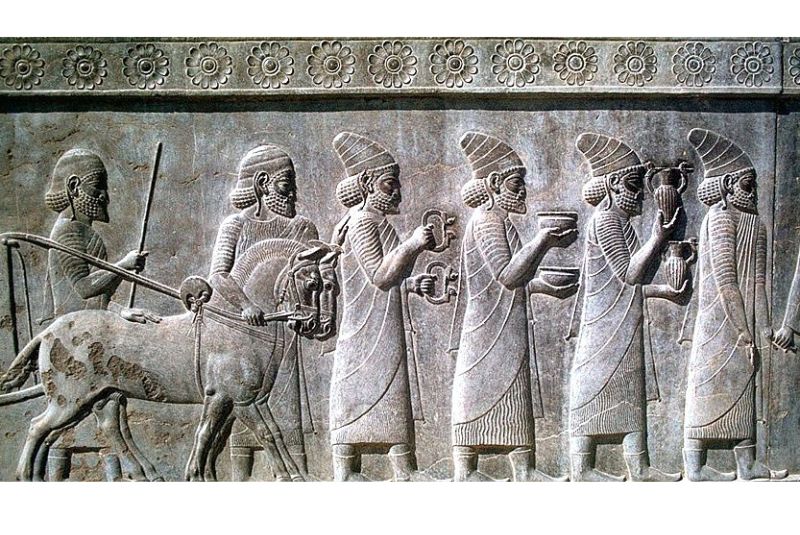
History of Persian Art
Ancient Persian art's enchanting voyage spans ages, leaving an indelible mark on human creativity. Emerging with Elamite intricacies, its zenith came under the Achaemenids, shaping Persepolis' splendor. Hellenistic exchanges and Parthian finesse paved the way for Sassanian grandeur, epitomized by intricate rock reliefs.
Islamic currents melded with Persian aesthetics during the Islamic era, influencing architecture and calligraphy. The Seljuks introduced iconic turquoise tiles, while Timurid refinement adorned manuscripts. Safavid opulence birthed Persian miniatures and lavish tilework.
As history churned, the Qajars embraced European elements, culminating in the dynamic modern era. Today, Tehran stands as a testament to this artistry, harmonizing tradition and contemporary expression. Persian art's journey narrates a saga of creativity, adaptation, and unwavering reverence for cultural heritage.
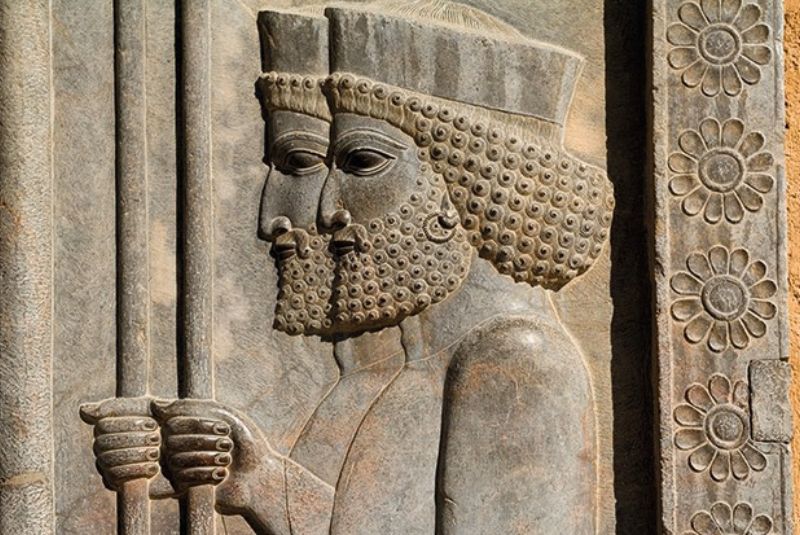
Art in the Persian Language
In the heart of Persian culture, "Persian art" carries the weight of its eloquent name, "Honar." Just as the Persian language flows gracefully, so does its artistic counterpart. The term "Honar" encapsulates more than mere creativity; it embodies a legacy of beauty and depth that transcends time. "Honar" harmoniously merges the aesthetic with the profound, expressing the essence of an ancient civilization's spirit.
Each brushstroke, every melody, and every intricate design reflects the fusion of "Honar," weaving together history, tradition, and innovation. As the rhythm of Persian art reverberates, it's the poetic resonance of "Honar" that guides the artist's hand, telling stories that span generations. Within this word lies the heartbeat of a culture, painting a vivid picture of a people who have celebrated life's splendor through their artistic tapestry.
Characteristics of Persian Art
Persian art is a realm where intricacy and harmony unite to create masterpieces that transcend time. Its defining traits breathe life into every stroke, shape, and form, forging an artistic identity that resonates globally.
- Intricate Details: At the heart of Persian art designs lies a meticulous attention to detail. Whether it's the mesmerizing patterns in Persian carpets or the delicate strokes in miniature paintings, each element is crafted with precision, weaving a narrative that invites deeper exploration.
- Harmonious Designs: Persian artwork is renowned for its harmonious and balanced designs. Every composition, from architectural wonders to calligraphic scripts, exudes a sense of equilibrium that reflects the cultural values of balance and symmetry.
- Narrative Essence: Old and modern Persian art are more than visual splendor; they are vehicles for storytelling. Whether through the vibrant colors of a tile mosaic or the graceful curves of a script, each creation narrates tales of history, religion, and mythology.
- Cultural Fusion: Iranian art is a melting pot of influences, shaped by encounters with neighboring cultures. The seamless incorporation of elements from various civilizations showcases the adaptability and openness that characterize Persian creativity.
- Elegance and Refinement: The elegance associated with Iranian art is inextricable from its refinement. Be it the curves of calligraphy or the shimmering motifs of ceramics, Persian art exudes an aesthetic finesse that captivates the senses.
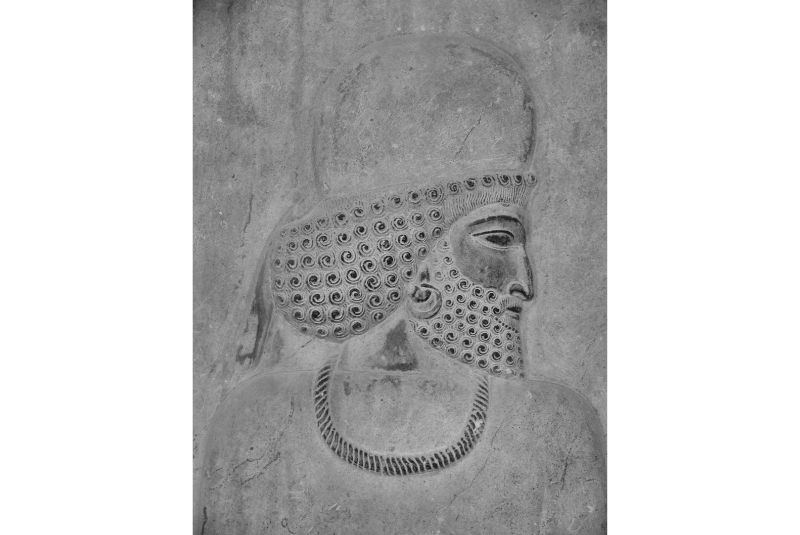
Is Persian art Islamic?
Persian art's tapestry is intricately woven with Islamic influences, yet it spans beyond this defining connection. Persian art has deep roots predating Islam, echoing the cultural diversity of Iran's history. While some of Iran's iconic mosques and creations from the Islamic era are often labeled "Islamic art," it's important to note that Persian art's scope is broader.
Iranian art thrived across dynasties, absorbing various cultural currents, resulting in a distinct identity that transcends religious lines. The Islamic era, however, left an indelible mark, introducing mesmerizing calligraphy, geometric patterns, and architectural marvels. This synthesis underlines the synergy between faith and creativity. Recognizing the dual facets of Persian art – as a bearer of historical legacy and a canvas for spiritual expression – we navigate an artistic narrative that intertwines with, yet extends beyond, Islamic realms.
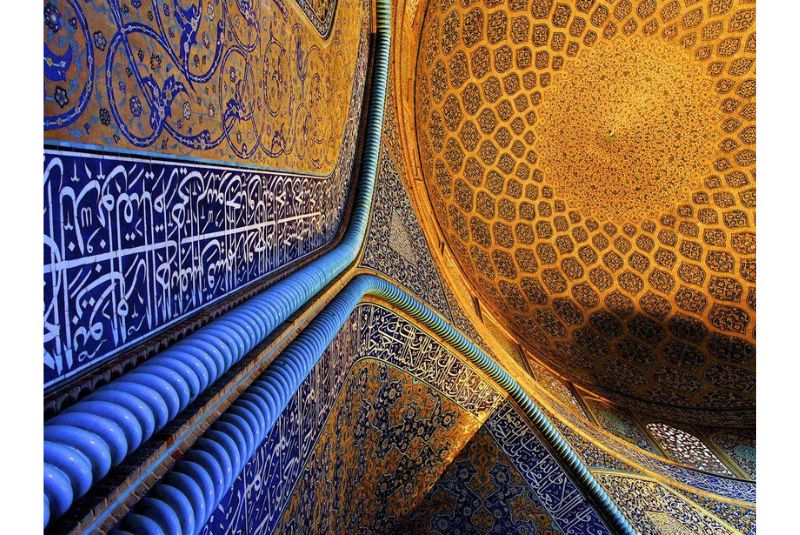
Famous Persian Arts and Artists
Persian art has birthed renowned masterpieces that echo through history, some gracing global museums, others adorning architectural marvels.
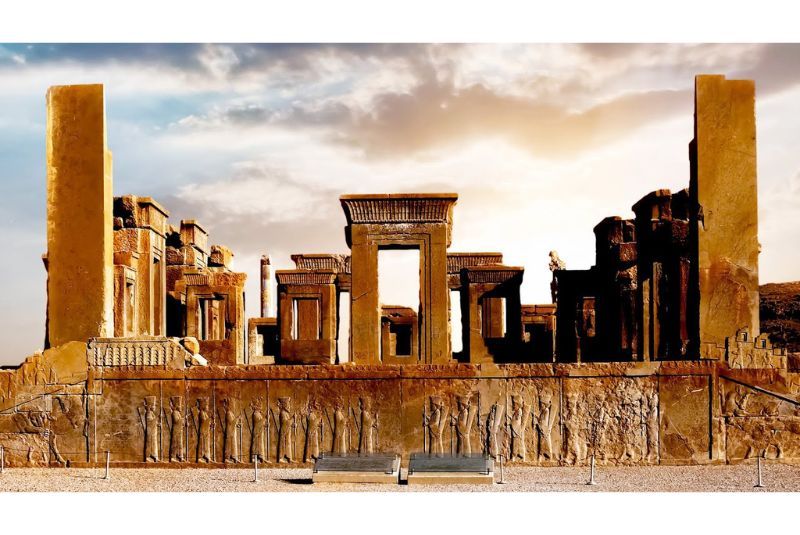
Renowned Iranian Arts
- Persepolis: Majestic ancient site with intricate carvings and sculptures.
- The Cyrus Cylinder: A remarkable artifact held in the British Museum.
- Mihrab from the Madrasa Imami: A masterpiece of Persian inspired Islamic tilework at the Met Museum.
- Frieze of Archers: Now housed in the Louvre Museum in Paris, a striking testament to ancient Persia.
- Shahnameh Illustrations: Exquisite miniatures celebrating Persian epic poetry.
- Ardabil Carpet: A breathtakingly detailed carpet displayed at London's V&A Museum.

Notable Iranian Artists
- Kamal-ol-Molk: Famous for "The Mirror Hall" painting.
- Farid al-Din Attar: Renowned for his Sufi poetry, especially "Conference of the Birds."
- Mahmoud Farshchian: The master of miniature painting, one of most remarkable Old Persian painting style.
- Parviz Tanavoli: Celebrated sculptor, known for "Heech" sculpture.
- Shirin Neshat: Acclaimed for her thought-provoking photography and video art.
- Monir Shahroudy Farmanfarmaian: Known for intricate mirror mosaics.
- Abbas Kiarostami: Iconic filmmaker behind "Taste of Cherry."
- Javad Maroufi: The most famous Iranian composer and pianist.
Examples of Persian Art Forms
Persian art is an expansive canvas that encompasses a multitude of artistic expressions, each bearing the mark of cultural richness and ingenuity.
- Persian Calligraphy: An art of expressive writing, Persian calligraphy transforms words into visual poetry. One of the most famous works is the "Blue Qur'an," an exquisite manuscript showcasing intricate calligraphy.
- Persian Miniature Painting: These intricate artworks narrate tales of history, literature, and myth. Among the most famous is the "Shahnameh," Ferdowsi's epic, brought to life through mesmerizing miniatures.
- Persian Sculpture: Carved narratives, often depicting cultural symbols, create tangible connections to history. The "Frieze of Archers" from Persepolis is a remarkable example etched in stone.
- Persian Mosaic Art: As one of the best Persian wall arts, Tile mosaics adorn Iranian mosques and palaces, with Nasir al-Mulk Mosque's stained glass and tilework standing as an extraordinary masterpiece.
- Pottery and Ceramics: Utilitarian and artistic, pottery embodies cultural motifs and stories. The ceramics of Lajvardina (blue tiles) and the Haft Rang (seven colors) capture the essence of Persian craftsmanship.
- Minakari: Enamelwork on metal, Minakari showcases vibrant colors and intricate patterns. The "Pahlavi Crown" is a prime example of this captivating art form.
- Ghalamzani: Elegantly etched metalwork transforms everyday objects. The "Silver Bowl" from the Safavid era exemplifies Ghalamzani's ornate beauty.
- Hardstone Carvings: Precious gemstones are carved into intricate sculptures. The "Gemstone Globe" is a stunning example, capturing both artistry and scientific precision.
- Clothing: Iran's diverse regions boast distinct traditional clothing, with intricate fabric-making and sewing. Each attire tells a story of heritage and identity.
- Jewel Making: Persian jewelers craft intricate pieces, often showcasing precious stones like turquoise and lapis lazuli.
- Dance and Music: Each region in Iran has its own dances and folkloric music, from the Sama dance to Kurdish and Lorish traditions. Even funeral ceremonies have unique musical expressions in the southern regions.
- Instrument Making: Qanun, Oud, Tar, Dotar, Setar, Kamancheh, Ney, Tonbak and Dayereh stand out as remarkable Persian musical instruments, producing enchanting melodies.
- Carved Rock Relief: The "Naqsh-e Rustam" site bears rock reliefs depicting royal power and historical events, offering a glimpse into ancient Persia.
- Weaving: Persian carpets, exemplified by the Ardabil Carpet, are globally renowned for their intricate patterns and rich storytelling.
- Architecture: The iconic dome of the Sheikh Lotfollah Mosque and the awe-inspiring Persepolis showcase the architectural brilliance that has characterized Iran through the ages.
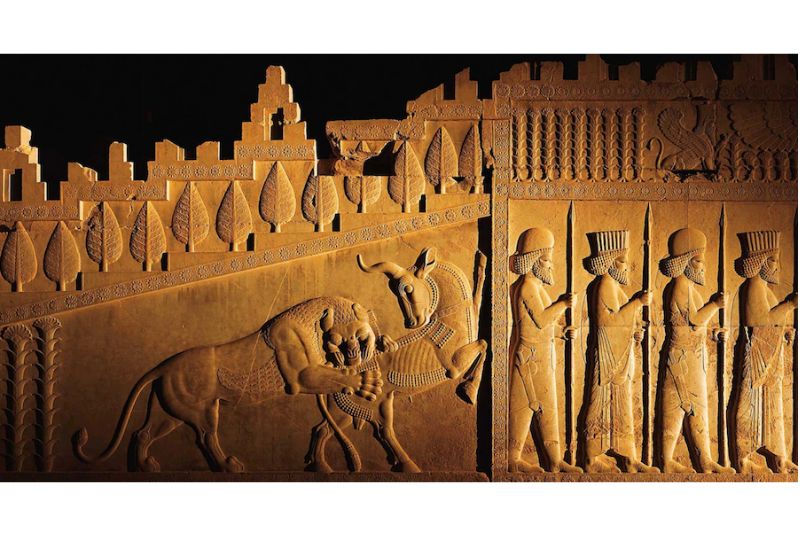
Most Famous Symbols of Persian Art
Persian art is adorned with timeless symbols that encapsulate the essence of culture, beliefs, and identity, resonating through generations.
- Sun: A potent symbol of light, warmth, and life, the sun signifies eternal energy and resilience in Persian art.
- Simurg: A mythical bird embodying purity and renewal, the Simurg symbolizes spiritual growth and transcendence.
- Faravahar: An iconic emblem of Zoroastrianism, the Faravahar represents divine guidance, morality, and human choices.
- Lion: A representation of strength, courage, and nobility, the lion appears as a guardian, embodying regal virtues.
- Huma, the Heavenly Bird: A harbinger of fortune, the Huma bird represents hope, healing, and the search for enlightenment.
- The Shirdal: A mythical lion-like creature symbolizing power and authority, often adorning Persian architecture.
- Mount Damavand: The highest peak in Iran, Mount Damavand represents strength, immortality, and national pride.
- Bote Jeghe: A stylized paisley motif, the Bote Jeghe signifies growth, fertility, and the perpetual cycle of life.
- Anahita: The water goddess of Persia, Symbolizing fertility and divinity, Anahita embodies life-giving waters and the feminine essence.
How Persian Art Influenced Other Cultures
Persian art, with its intricate beauty and profound symbolism, has radiated beyond borders, leaving an indelible mark on artistic traditions worldwide.
- Islamic Art: Persian calligraphy and architectural motifs influenced Islamic art, shaping intricate designs in mosques and manuscripts.
- Mughal Empire: Persian miniatures inspired the Mughal School of painting in India, giving rise to masterpieces like the "Padshah-nama."
- Ottoman Empire: Persian patterns and tilework left an imprint on Ottoman art and architecture, adorning palaces and mosques.
- European Renaissance: Persian carpets captivated European nobility, influencing tapestry design and inspiring artists like Hans Holbein.
- Chinese Art: Persian ceramics' impact can be seen in Chinese porcelain patterns during the Yuan and Ming dynasties.
- Central Asian and Turkic Art: Persian influences resonate in Central Asian carpets and Turkic metalwork, bridging cultures.
- Contemporary Art: Persian artistic themes, from calligraphy to symbolism, have permeated modern global art, connecting diverse visions.
Iranian Modern Art
Persian modern art seamlessly intertwines tradition and innovation, crafting a dynamic fusion that echoes the nation's cultural identity. While rooted in the echoes of history, contemporary artists infuse their creations with themes reflecting the present. Traditional techniques, such as Persian calligraphy and miniature painting, find new life alongside explorations of societal shifts, identity, and global connectivity. This artistry encapsulates the essence of Iran's heritage while embracing the fluidity of modern expression, bridging the past and present in a vivid tapestry of creativity.

